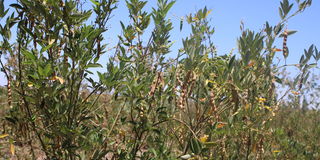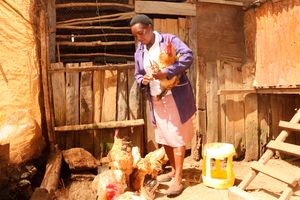Drought-defying farmers create an agriculture miracle in Laikipia’s drylands

A pawpaw farm in Thome Village, Laikipia County on March 6, 2025.
What you need to know:
- The economic benefits have been immediate and substantial. From his five-acre farm, Mr Lengawa expects to harvest approximately 75 bags of beans worth about Sh600,000 – equivalent to selling 75 sheep, but achieved in just three months.
In the heart of Laikipia's semi-arid landscape, an unexpected green oasis is taking root. Dedan Kimathi Foundation Thome Village, located 20 kilometres from Rumuruti town, has become ground zero for an agricultural transformation that could revolutionise food security in Kenya's drylands.

A orange farm in Thome Village, Laikipia County on March 6, 2025.
The natives, traditionally pastoralists, are gradually embracing modern conservation agriculture techniques introduced by new settlers. The introduction of fodder trees, fruit trees, and drought-tolerant crops like pigeon peas, sorghum, cassava, and groundnuts is not only enhancing the aesthetic appeal of the dry area but also contributing to environmental sustainability and resilience against climate challenges.

A sorghum plantation in Thome Village, Laikipia County on March 6, 2025.
"We have seen and felt the impact of environment conservation and climate-smart farming in addressing food security," says Martin Macharia, Thome chief, describing the remarkable changes that began in 2019 when new settlers arrived in the village with different farming techniques.
Lemako Lengawa represents the evolving mindset of local pastoralists. Though still maintaining a flock of 300 sheep, he has diversified into crop farming, growing sunflowers and beans on five acres using agroforestry techniques.

A pigeon pea plantation in Thome Village, Laikipia County on March 6, 2025.
"I was born and brought up here in a pastoralist family, but I have diversified to crops and trees," explains Mr Lengawa. "The trees provide shade for the family and my livestock. Our neighbours at Dedan Kimathi Foundation guide me in farming and inter-cropping."
The economic benefits have been immediate and substantial. From his five-acre farm, Mr Lengawa expects to harvest approximately 75 bags of beans worth about Sh600,000 – equivalent to selling 75 sheep, but achieved in just three months. Additionally, his sunflower crop will provide cooking oil and byproducts for animal feed.
What makes this transformation remarkable is how these farmers are adapting techniques to suit the harsh environment. While some use borehole water for horticulture, most have adopted drought-resistant crops inter-cropped with drought-tolerant trees.
Alfred Ngunjiri, one of the farmers, has created a diverse agricultural system. "The fruit trees are all drought-resistant varieties requiring minimal rain," he explains. "They provide shade, protecting horticultural crops from the scorching sun and effectively reducing evaporation."
This approach has transformed the landscape. Walking through the village reveals farms with sweet aromas from mixed agroforestry, flowering orchards, and productive fruit trees. Mature pawpaws, orange trees, apples, red capsicum, and pumpkins flourish alongside sorghum planted under protective tree cover and pigeon pea plantations ready for harvest.
The success of these methods is inspiring the wider community to adopt similar practices. "We have realised that the virgin lands are very fertile and suitable for organic farming. Our livestock provides us with sufficient manure," says Clement Lang'at, a resident.
Johnstone Macharia, who moved from Ndeiya in Kiambu County to Thome Village, exemplifies how settlers have adapted to local conditions while introducing new innovations. He pioneered pig farming in the village – an unusual choice that serves multiple purposes. The pigs provide security by alerting him to intruders, and bandits aren't interested in stealing them. Additionally, he has mastered livestock herbalism and grows fodder trees with medicinal properties.
"With the fodder trees that include sesbania, dombeya torrida, and lucern, my sheep, pigs, and poultry never starve in drought," Mr Macharia explains, adding: "Livestock matures faster in this type of climate."
Eric Lolmodooni, an environmentalist, sees broader implications for Kenya's food security challenges. "The transformation taking place at Dedan Kimathi Foundation Thome Village is very encouraging. It shows how communities can complement each other for survival," he observes.
The integration of indigenous trees, fruits, and fodder species serves multiple purposes: environmental conservation, animal feed, and climate resilience. "Planting more trees would drastically reduce losses pastoralists experience during droughts, lengthen the life of pastures, and offer supplemental animal feed," he adds.
For this transformation to reach its full potential, several interventions are needed. Mr Lang'at calls for government support through expanded irrigation infrastructure and access to drought-resistant crop varieties and tree seedlings.
"With irrigation water, this area can be very productive, growing enough for family consumption and markets across the country," he argues.
“The success in Thome Village has revealed hidden potential within our area regarding food security and climate change factors."
As climate change intensifies droughts across East Africa, this community-led agricultural revolution offers a promising model. By blending traditional knowledge with innovative farming techniques, these farmers are not just adapting to harsh conditions – they're thriving in them, creating a blueprint that could transform food production across Kenya's arid and semi-arid regions.





